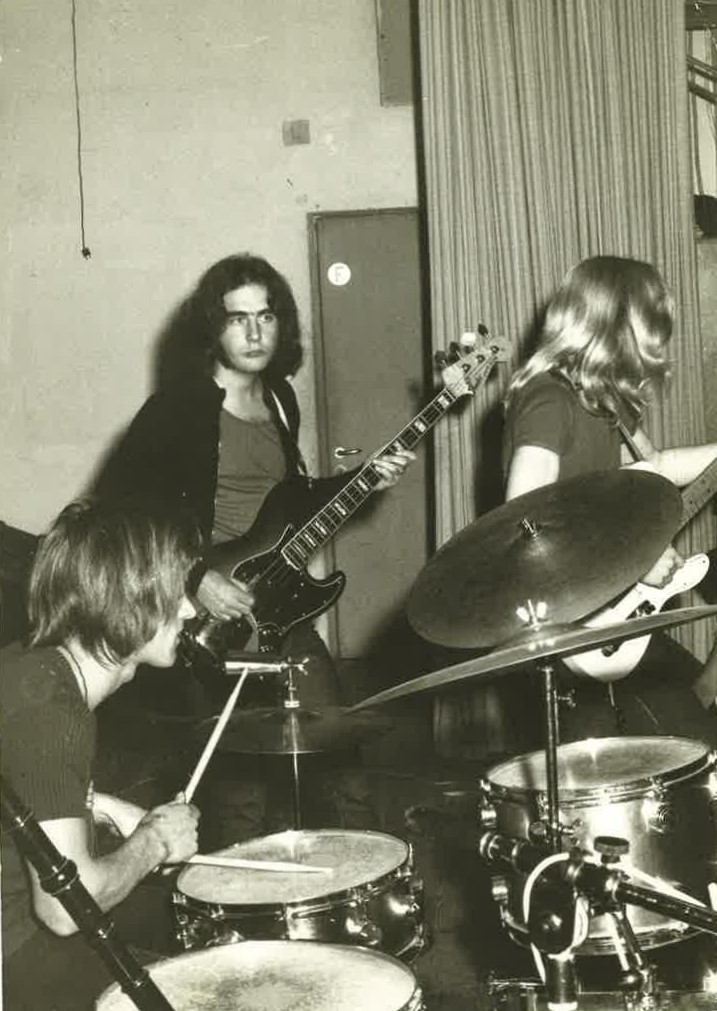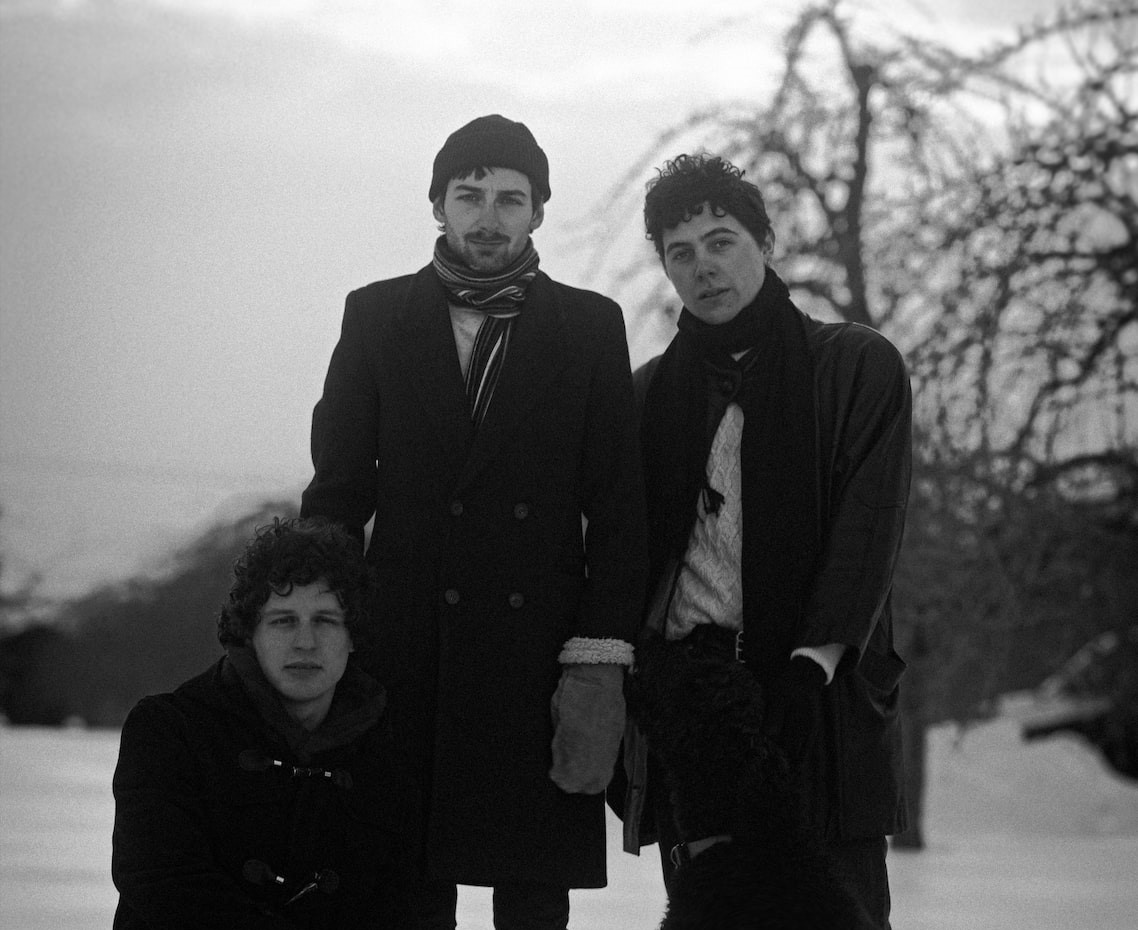Novo Line
“I have learned to find the joy in cheap and free things”
With Dyad Novo Line made a post-New Beat and industrial pop record that, as the liner notes mention, could be played at 33 or 45 rpm.
I was looking at this live clip and the first thing I noticed was your gear, especially the two Atari ST PC’s. So I have to ask why do you use an Atari ST? Where did you find these Atari’s?
Nat Fowler: I got the first one just a month before I came up with this project, in 2011. From 2004-2007, I had been living in a small town in Italy for nearly four years, and without much to do, started collecting old computers, in the hope of using them to make video and music. I used to be in a band in Baltimore, but without much success in finding others to collaborate with, I tried many many things using old and new tech. In the small town I was in, I was lucky to get a lot of old stuff for either really cheap or for free. After 4 years in Berlin, my landlord at my studio space gave me his old Atari ST, that he used to use for making music in the 90s. I knew only a little about that computer at the time, because a friend of mine used to come visit me in Berlin and bring his Atari STacy with him and we’d jam and he’d record the MIDI!
So I had this idea of playing with MIDI, but I hated the idea of doing a live performance that was just playback. Anyway, all my Atari STs have either been give to me or I paid very little, here in Berlin.
Do the Atari’s break sometimes?
Sure they break.
Are you able to fix them yourself?
I can fix them mostly. I replace power supplies, disk drives, etc…
Why do you use two Atari’s?
Two Atari STs enable me to add a layer of complexity not possible with one. I use the computer like a dedicated piece of hardware for live performance, and each one can instantly change what key it’s playing in, the BPM, the scale used, etc. When I began to understand how to use this “instrument” better, I decided to try two at the same time, and it was on another level, so I couldn’t go back to just one!
For how long do you work with Atari’s now?
As I touched on already, it was just July of 2011 that I started playing around with one. After a month I knew what I wanted to do with it. After 2 years I added the second ST. I’ve realized through many years playing music and making videos, that if I set up a method of working that produces “happy accidents,” I’m the most creative, as I play off of these accidents myself. You could watch my old band’s live performances (although most of it is pre-youtube era so not much is well documented) or the old videos I made with my friends in Baltimore and see that my way of constructing the specific approach goes very far into the actual production of a completed piece.
For me, working with this is an “instrument” – and I call it instrument because I dont think I use it like a personal computer is normally used to make music, and we should always remember that these computers are MUCH slower than modern ones and can hardy be considered computers by our standards. I just looked it up to get some real figures on this: An Atari ST ran a little less than 1 MIPS! MIPS is “millions of instructions per second,” a term that really had no meaning to anyone with a PC until the Motorola 68000 chips running at 4Mhz started to be used! Now, for example, an Intel Core i7 running at 3Ghz 238,310 MIPS.
So I’ve been spending the last 6 years leaning to use this “instrument” of mine, learning to play two at the same time, and more recently 3 and 4 at the same time, giving me even higher “dimensions” to go into. I kind of picture what I’m doing while I’m playing as two different planes intersecting in 3D space within my head. With the third and fourth ST, I’m not quite sure yet what it is, that’s what I’m learning now- to see if I’ll end up visualizing that 3rd and 4th dimension somehow.
What did you learn from working with ATARI’s?
What I’ve learned is a long list, but most of it is related purely to my own practice; like that 3D space idea, or learning the skill of listening to a randomly generated melody instead of watching its MIDI note grid on a screen, as the “instrument” only gives me little flashing note symbols for visual feedback of what it’s doing, and deciding what I can do with it only by listening and thinking (what to do with it is a lot of things, but for example changing its key to match the key of another randomly generated melody).
Did your working methods change over time?
As far as methods changing, I would say that they always change, but my successful changes that I keep and unite with what I’ve found to work before, are all related to this idea of making a process, or a way of doing things. When I have a nice mix of ways-of-doing-things, then I improvise with those ways, and the result is the music. It’s impossible to recreate a piece. It may come out similar – in certain ways – but never the same, it is literally impossible.
The other parts of your set-up also seems to be old/vintage stuff; analog synths, vintage hard- and software.
My equipment is basically chosen for its production date, its special features, its sound, and of course it has to have MIDI. None of what I use is analog actually; I’ve tried a few MIDI enabled vintage analog synths but they didn’t seem to fit in well with the sound I had created based on what I started with, which was a DX7ii and a Boss DR660 drum machine. Pretty much I’ve followed this line since, building on what I started with instead of making any revolutionary changes, soundwise. I’ve found that the things that were made around the same time as the software I use was made (1988) play well together. I’ve concluded that it’s because this software on that specific hardware (the ST) was written at that time to work with the instruments/equipment that was available at the time. So I try to keep this idea as much as possible in the process.
Can you tell me: what is your set-up?
The setup is two ST’s as two “brains” in a sense, that spit out MIDI, merged together, into a rack of drum expanders and FM synthesizers, plus a sampler, which I constantly re-sample from audio that I have playing in loop from my phone (the only modern piece of equipment!) I used to use a cassette player here in this place but as my overall live equipment setup got to be bigger with the second ST, the cassette player became a burden to bring along.
Is your live set-up a copy of your studio?
My studio is now, after all these years of collecting, much more equipt. I’m always challenging myself to find a way to incorporate as much of it as possible into a way of working where I can use any instrument in as many ways as possible, in order to come up with new ideas to add to the process. When I choose what I will bring for a live setup, I’m making the choice of what to bring and how to use it, based on what I’ve learned from the experimenting in the studio.
Do you think that, because of the kind of gear you use, your sound brings the listener back to late 80s/early 90s European dance music? In other words: does the instrument dictates the player? And should it be this way: that it’s about the instrument, not about the player?
It’s about both, and each is very different from the other. No one else could make music like I do, because no one had the specific background I did and the interests I did. I’ve always liked specific things about songs and music that isn’t always what others like about it. I bring what I like, and what I feel is missing from what I don’t like, into how I build my process. Because of the equipment, it kind of “sounds” like late 80s and early 90s. The DX7 of course has a very recognizable sound, as do the drum samples used. If you have the same drum sound and same synth sound, you’re going to be reminded! For example, In my old band we used rock guitars; Gibson SGs and Kramer 450/350s through Marshall JCM800 amplifiers (Gibson/Marshall is, if you don’t know, Angus the guitarist of AC/DC’s live setup), Pearl/Zildjian drums; but we made music that was not three chords, a steady drum beat, with a man screaming/singing, all of it lining up rhythmically and melodically every 4th beat, for 3-4 minutes. It sounded like AC/DC but it also didn’t. Holly Herndon, the contemporary electronic music artist, once remarked that I have a great “sound palette” and I like this idea, we used the 70s-80s Hard Rock sound palette for my band, and I now use the digital/MIDI revolution of the mid-80s as a sound palette. This is an umbrella that a lot of genres fall under, but what’s most jarring to think about is that I’m using a lot of the sounds, and mis-using a lot of the methods, that Pop music was using in the 80s. I’ll listen to something produced by Jellybean or Stock, Aiken and Waterman and think of a way to turn it on its head or recontextualize. 80’s-era Italo Disco, and New Beat also used this same equipment.
I’m 42 and grew up in Afflgem, Begium, next to a disco called L’Orange Mécanique, and close to De Villa in Kobbegem, both part of the history of New Beat. Because I was too young to go out when New Beat took place (and because New Beat was over when I could go out), I have an eternal fascination for this kind of music. Your Dyad LP sound very ‘Belgian’ to me. I hear New Beat in it, but also Front 242 and Fat Gadget. So to come to my question: how did you get into this kind of music?
Well that could be a long and detailed story. Before this very slow resurgence of New Beat we are currently in, I found out about that genre purely by accident, after realizing that I already had a few New Beat records, after seeing some random contemporary DIY band’s theft of the Rhythm Device “Acid Rock” video for their own song. I saw that video and for some reason I had to know what it was, and so when I found out what it was, and where it came from, I realized I had records like it, and since I loved it soon I was on a mission to find more, now that I knew what it was called! This was before everything was so easy to find on the internet mind you… Anyway New Beat had, to me (and remember maybe what I say won’t make sense because a lot of the time I hear things and like things about music that others don’t either notice or agree with) a certain quality that I loved of 80’s era Italo Disco (that I got to know very well by listening to a radio station in Italy), combined with industrial, which I grew up listening to in the 80s along with punk/hardcore/etc.
When I was a kid, there were two things I was not allow to do with my father’s record player: putting my toy cars and my He Man action figure on the record player, and changing the speed of the record player. On the Computer Controlled Acoustic Instruments EP by Aphex Twin, there’s been written: play at 33 or 45. You do that too on this 12”: saying: play at 33 or 45rpm. So I have to ask: why?
Well, this will circle back to the long story I avoided in the last question: I collect 12” 45RPM maxi-singles of Pop hits. They were always to be found at flea markets super cheap, because no one wants to buy a record with only one or two songs and a different version of the same song. These kinds of records are also nearly always in great condition, because people never really played the record that much; you would own the thing, but you also probably bought the album and listened to that so you wouldn’t have to get up and turn the record after 5-6 minutes. Or the record was owned by a DJ, who took good care of it. And most of these records were pressed to be played on the radio, or in the club, or at a rollerskating rink, etc. So they were engineered to be LOUD, they had great dynamics, and they were of course state-of-the-art in audio fidelity, production-wise, because they were pop hits of the day. So what I like to do is play these records on great sound systems, at 33RPM, because they sound HUGE. I used to do DJ sets of purely slowed down 80s pop hits, but of course this can get really annoying (never for me of course) so I started searching for other records that had a similar “sound palette”, were pressed at 45RPM, and were also really cheap (I hope you’re seeing a trend here; I’ve never been successful at making money, so I have learned to find the joy in cheap and free things!). Lo and Behold, New Beat records fit this list of criteria to a T. So without knowing it, I began DJing New Beat records at 33RPM, a genre that, if I’ve been informed correctly, was partially based on approximating the sound of normal (of the day) dance records slowed down to 33RPM!
So I’ve been interested in slowing down records for a while. In 2002 my band released an LP with one song pressed at 45RPM in the middle of it, so that when you were listening to the album, you’d unexpectedly hear this slow drudgy thing in the middle, which was actually the fastest song on the record, if you played it at the “correct” speed. With my second LP for Ecstatic, I wanted to find the pieces I’ve made that worked, on one level or another, at both speeds. I admit that some sound “too fast” at 45RPM and others sound “too slow” at 33RPM, but they all have qualities that make them work at the “wrong” speed as well. I didn’t even know about Aphex Twin’s record you mentioned. People gasp and blanch when I say this, but I’ve never liked his music very much.
To come back to the theme of my first question: do you see your music as retro?
I don’t see it as retro. Of course I understand why some/most people think it’s retro: I’m using all old equipment, it also “sounds” retro because it’s all that old equipment. But “retro” comes from the intention of an artist as well. When I got so many Commodore 64s for free when living in Italy, I wanted to make music with the sound chips inside. I went as far as even building a MIDI enabled synth using for C64 SID chips. But if I listen to 99.99% of “Chiptune” music, after 2 minutes I want to bang my head against the wall and ask myself what the fuck, why is this person just completely copying this old way of doing things, making music exactly the same as it was for a bunch of video games 30 years ago?? THAT is retro to me.
Should it be an artist goal to ‘push things forward’? Can one be nostalgic in the avant-garde?
So I guess yes, an artist should push things forward. If I want to listen to video game music on a SID chip (and ok, yes, sometimes I do), I will listen to the actual thing; the actual talented artists that were inspired by the equipment of the time and made something completely new. And I don’t want to pick on chiptune specifically, I’m just as much of an unforgiving asshole about lots of other genres; but that’s the problem with genres, 99.99% of it sounds the same, as the genre has defined how the music is made, instead of whatever magic and circumstance is involved in making the things that start genres.
I was watching this video where Roman Hiele interviews Felix Kubin. Kubin talks about ‘new’ electronics being made because people didn’t know how to use their gear, or used it in a wrong way, which created new sounds. Does this count for you too? Does new music sometimes gets created ‘by accident’?
Absolutely! He’s totally right. And I think that’s what’s missing from a lot of modern electronic music. Not only from artists but also from software developers and manufacturers. The 303 and the 808 were NOT made to make Acid House. This is obvious. But most equipment now _IS_ made to make Acid House, and that’s the problem.
– Joeri Bruyninckx
© Copyright http://www.psychedelicbabymag.com/2017














yeeeeeee! first one!